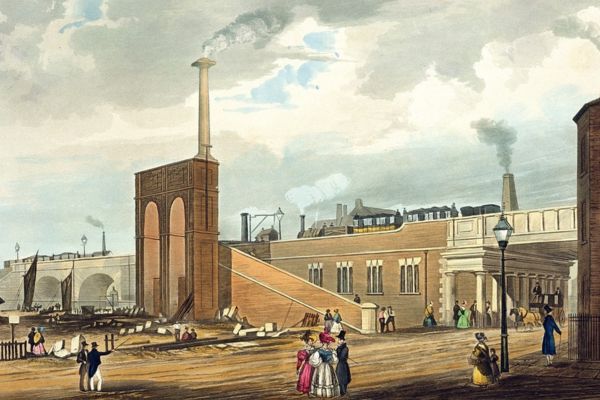Making connections and transport links
The Station Agent’s House lies within Castlefield Conservation Area of Manchester, named after the four Roman forts built here because of an intersection of roads and the Rivers Irwell and the Medlock. It was this very transport connectivity that attracted both the Romans and the Liverpool & Manchester Railway (LMR) to the area. Prior to the railway, in the 18th century Francis Egerton, 3rd Duke of Bridgewater, his land agent John Gilbert and his millwright James Brindley, built the first modern canal, the Bridgewater Canal, through to Castlefield. The area became a major transhipment point and a variety of industrial premises developed along the canals and rivers.

The coming of the Railway
Through the industrial revolution one of the persistent challenges was transporting imported raw cotton from the docks at Liverpool to the weaving mills of Lancashire and then the finished goods back to Liverpool to re-export around the world. Travel was by canal, smooth but slow, and hard to manage at scale. Engineers and entrepreneurs applied themselves to this conundrum and in 1826 construction of the world’s first purpose-built passenger and freight line, the Liverpool and Manchester Railway, was authorised by Act of Parliament.
The newly formed Railway Company began planning the railway route in the early 1820s, under the initial supervision of engineer George Stephenson. The only available plot for a Manchester passenger terminus was a house at the corner of Liverpool Road and Water Street, built in 1808 for John Rothwell, who was a partner in the nearby Rothwell & Harrison dyeworks. George Stephenson spotted this plot’s potential and it was duly bought by the Railway Company.
This well-placed, simple but handsome house became the dwelling of the first Station Agent, Joseph Green. It was, and still is, the anchoring ‘pin’ around which all the rest of the station’s infrastructure then radiated. In 1830, a viaduct and bridge were built by George Stephenson behind the Station Agent’s House to bring the track to the departures platform. The world’s first railway warehouse – the 1830 Warehouse – was built opposite, and then the Coach Offices (soon called the Passenger Building) next door. Other Agents followed on from Joseph Green and by 1861, Thomas Kay was known as ‘station manager’. We have re-adopted ‘Station Agent’s House’ as the most historically accurate name for the earliest days of the railway.
“Flying through the country”
The Liverpool & Manchester Railway opened on 15 September 1830, with a prestigious guest list, including the Duke of Wellington, then the Prime Minister.
Large crowds thronged the route, but the celebrations turned sour midway through the inaugural journey after William Huskisson, MP for Liverpool, met with a fatal accident. When the trains stopped to take on water., Huskisson got out and was standing on the track talking to the Duke of Wellington, still in his carriage. Amid the noise, he failed to notice the steam engine Rocket approaching along the adjacent track. It struck Huskisson, who died later that day. When the delayed convoy eventually reached the Liverpool Road station, a further shadow was cast on the proceedings by the crowd’s hostility to the Duke of Wellington, no longer as a popular prime minister, and he declined to leave his carriage.
Of course, the railway became a roaring success. Within months, passenger traffic on the railway was exceeding expectations and within just four years, travelling by rail had put local stagecoaches and mail coaches out of business. One traveller, known only as EWS delighted that, “in a very few minutes we were flying through the country at the rate of twenty five miles an hour.”
Soon, the track was extended to what is now Manchester Victoria station nearer the centre of the city. Liverpool Road Station then became a major freight depot, servicing the Manchester cotton and other industries with commodities, and transporting away the factories’ products.
By the 1870s, the Station Agent’s House had been divided into flats for multiple occupants. In the mid-20th century, the ground floor was converted and fitted out as a shop, selling at various times sausages, automobile parts and no doubt other goods too. But by now, the railway was in decline.
After the Station Closure
In September 1975, British Rail closed Liverpool Road Station. However, recognising the site’s significance, talks had already begun with Manchester City Council to preserve the site as a heritage and museum centre.
In 1978, the whole site became what is now known as the Science and Industry Museum. The Station Agent’s House was restored as the first offices for Museum staff, but as the rest of the site was brought back into use, it was no longer needed, and the Museum turned to Landmark for help. The wider site around it has again seen great change in recent decades, host now to an awarding-winning museum complex and a vibrant new arts arena, the Aviva Studios, home of Factory International. Landmark’s involvement here is a thrilling opportunity to stay at the heart of the next chapter for this modest building that played such a pivotal role in the history of the railway and now lies at the heart of Manchester’s forward-looking ambitions.
For a short history of the Station Agent's House, please click here.
To read the full history album for the Station Agent's House please click here.